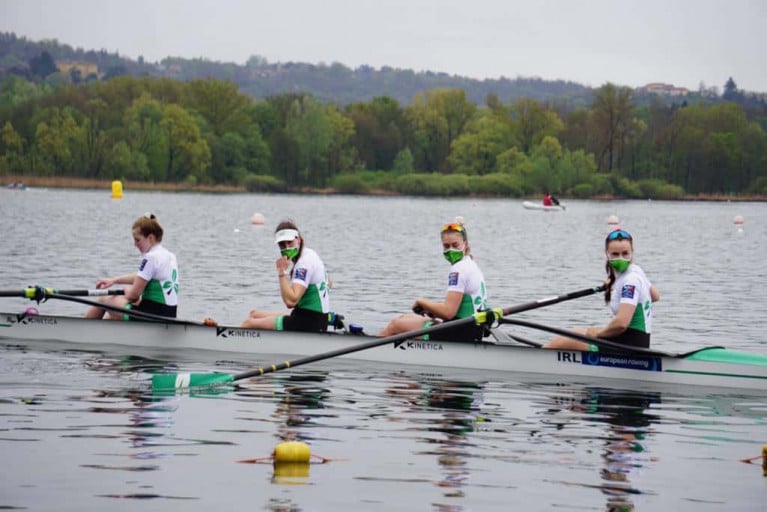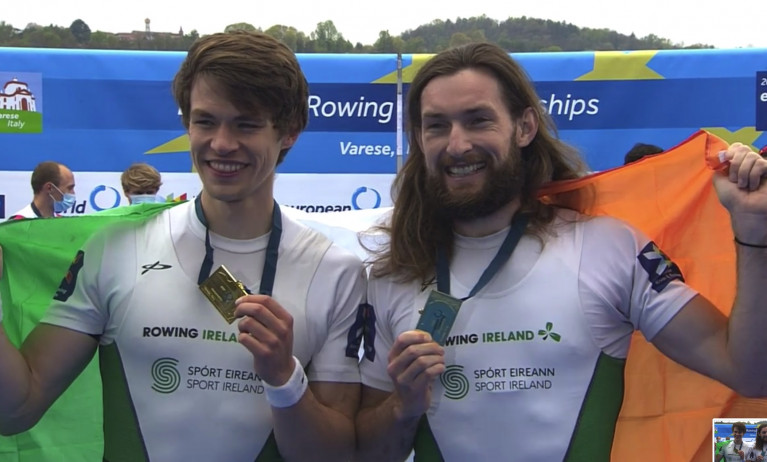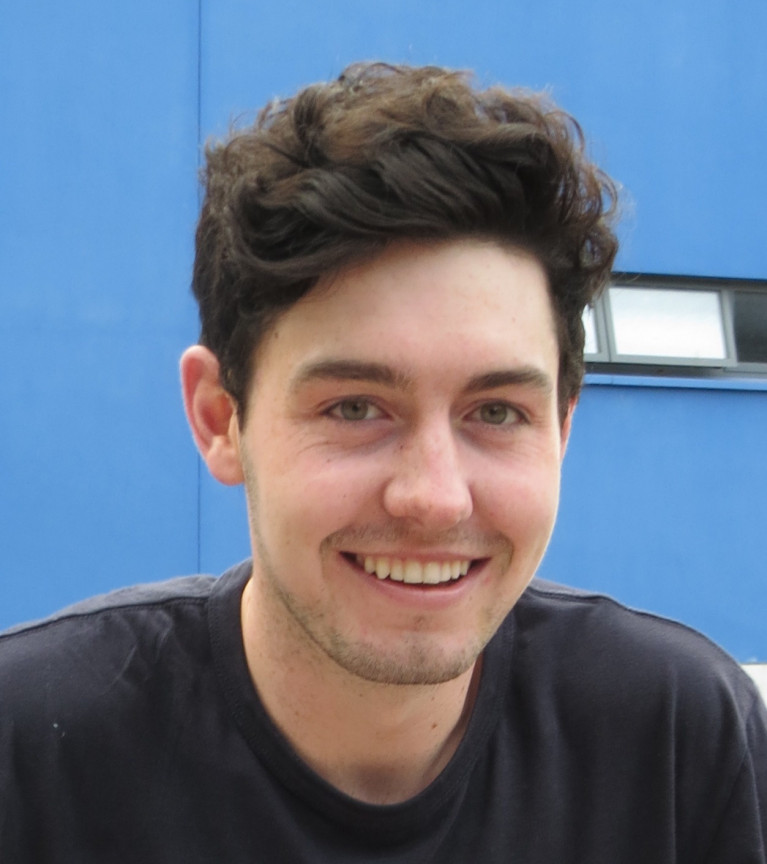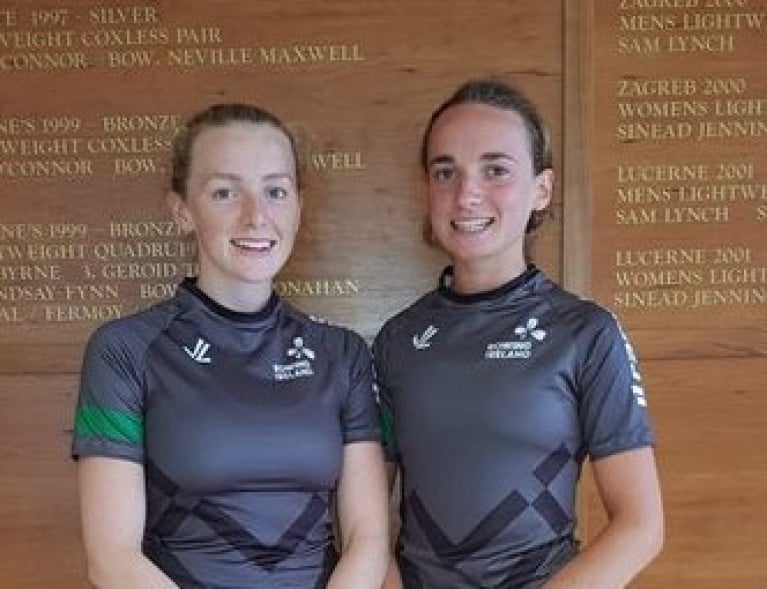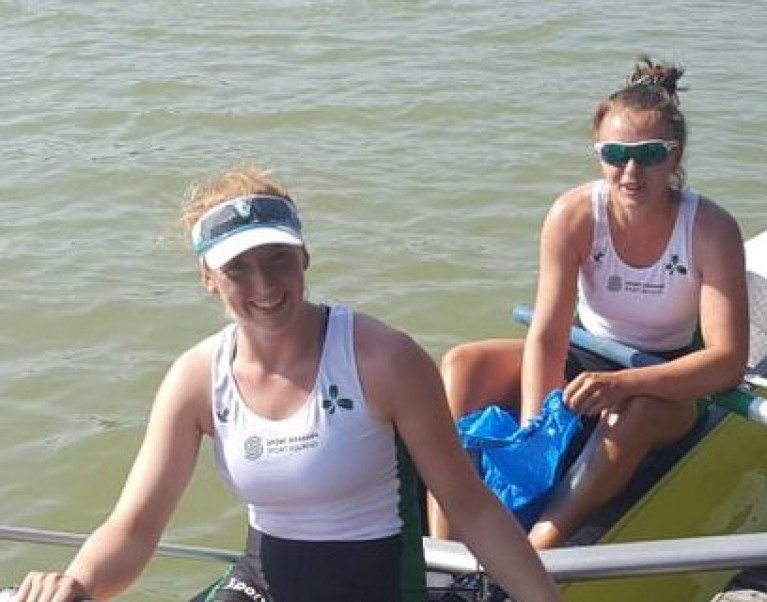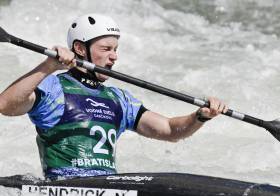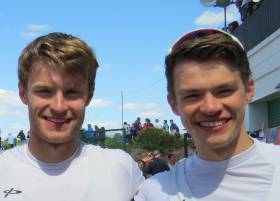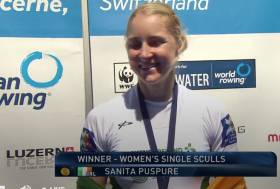Displaying items by tag: European Championships
Ireland Rowing Team Cancels Plan to Return Home Before World Cup
The Ireland rowing team which did so well at the European Championships in Italy will not return home as planned before their next outing in Lucerne in Switzerland. The team reached six finals and won gold and silver at the event and were due to return for a week to Ireland before going on to the Olympic qualification regatta and World Cup next month.
However, Ireland high performance director Antonio Maurogiovanni told Afloat today that he had spoken with the team and they had agreed that with the restrictions around Covid-19 quarantine becoming an issue it was more sensible to stay in their camp in Italy and then go on directly to Lucerne.
Two crews, the lightweight women’s double and the women’s four, will go to the Olympic qualification regatta (May 15th to 17th) and the rest of the team will compete at the World Cup (May 21st to 23rd).
Sanita Puspure, the world champion in the single sculls, missed the European Championships, but is set to join the team next week in Italy.
Gold for O'Donovan and McCarthy at European Rowing Championships
Paul O’Donovan and Fintan McCarthy won gold for Ireland at the European Rowing Championships today in Italy, adding to an excellent silver for the women’s four earlier.
The Ireland lightweight double saw off a spirited display by Germany, who led early on. Ireland moved decisively through the middle stages and took over the lead at 1300 metres. They then sprinted through the final few hundred metres to win by a length from Germany, with Italy third.
“It was a decent race, it’s good to be back,” O’Donovan said. “I was off last season so Fintan raced in the single last year. Fintan is just dragging me along in the double. We need bigger biceps. We’re gonna work on some curls which will see us through to the end of the summer.”
The Ireland women’s four looked impressive as they took silver in Varese.
The crew of Aifric Keogh, Eimear Lambe, Fiona Murtagh and Emily Hegarty raced so well that they pushed up very close to the Netherlands in a push for gold.
The new Irish combination started slowly, but slotted into the leading trio of the Dutch, British and Irish. In the third quarter the Ireland four pushed through Britain and then tested the Dutch coming to the line.
Britain, with Rebecca Shorten of Northern Ireland in the stroke seat, took bronze.
Keogh said: “The medal this year means a lot to us because were so close to Olympic qualification. A lot of crews from Ireland are already qualified, and for us to be able to finish that close to the Dutch is a really huge confidence boost.”
Earlier, the women’s pair of Aileen Crowley and Monika Dukarska showed well in the early stages of their A Final, but in a hot race they were pushed back to sixth at the finish. Britain’s Helen Glover and Polly Swann justified their favouritism to race to gold – but they were given a battle by Romania, while Spain took the bronze.
The racy lightweight double scull of Aoife Casey and Margaret Cremen gave a good performance in a superb final. Italy were the surprise winners from Britain and the Netherlands, with Ireland taking fifth.
Gary O’Donovan had to settle for fourth in his A Final of the lightweight single sculls. The race belonged to Peter Galambos of Hungary: he led through all four quarters. O’Donovan made ground in the closing stages, but was 4.3 seconds off Galambos at the finish.
Lydia Heaphy got off to a great start in the lightweight women’s single and led early on. However, Alena Furman of Belarus moved swiftly into the lead and stretched it down much of the course to win gold. Heaphy finished sixth.
Enniskillen woman Holly Nixon teamed up in the Britain double with Saskia Budgett to take a bronze medal in a race won by Romania.
European Rowing Championships, Varese, Italy, Day Three (Irish interest)
Men
Double Sculls – B Final (Places 7 to 12): 1 Ireland (R Byrne, P Doyle) 6:21.47, 2 Italy 6:22.52, 3 Germany 6:23.29.
Single Sculls – C Final (Places 13 to 18): 1 Russia 7:08.08, 2 Ireland (D Lynch) 7:09.01.
Lightweight Double – A Final: 1 Ireland (F McCarthy, P O’Donovan) 6:18.14, 2 Germany 6:19.94, 3 Italy 6:21.05.
Lightweight Single Sculls – A Final: 1 Hungary (P Galambos) 7:01.52; 4 Ireland (G O’Donovan) 7:05.82.
Women
Four – A Final: 1 Netherlands 6:27.51, 2 Ireland (A Keogh, E Lambe, F Murtagh, E Hegarty) 6:27.96, 3 Britain (4 R Shorten) 6:31.27.
Pair – A Final: 1 Britain 7:02.73; 6 Ireland (A Crowley, M Dukarska) 7:11.83.
Double Sculls – A Final: 3 Britain (1 H Nixon) 6:55.13.
Lightweight Double – A Final: 1 Italy 6:58.66, 2 Britain 6:59.56, 3 The Netherlands 7:01.13; 5 Ireland (A Casey, M Cremen) 7:07.42.
Lightweight Single Sculls – A Final: 1 Belarus (A Furman) 7:41.81; 6 Ireland (L Heaphy) 7:58.70.
Ireland Double Wins B Final at European Championships
On a day of promise for Ireland in A Finals of the European Rowing Championships, Ireland’s Philip Doyle and Ronan Byrne finished their campaign with a fine win in the B final of the double sculls.
Italy set the early pace in Varese, with Ireland and Germany closely tracking them through the middle and later stages. Doyle and Byrne produced a good sprint finish to win. This places them seventh overall.
The C Final was won by Norway’s Kris Brun and Are Strandli. The lightweight crew, which finished third at Rio 2016, campaigned in the open weight class at this event.
Daire Lynch finished his campaign in the single sculls quite well. He took a close-up second in the C Final behind impressive Russian sculler Nikolay Pimenov, who led down the course from the start. Lynch, who pushed hard at the end, places 14th overall at the Championships in a very tough event.
European Rowing Championships, Varese, Italy, Day Three (Irish interest)
Men
Double Sculls – B Final (Places 7 to 12): 1 Ireland (R Byrne, P Doyle) 6:21.47, 2 Italy 6:22.52, 3 Germany 6:23.29.
Single Sculls – C Final (Places 13 to 18): 1 Russia 7:08.08, 2 Ireland (D Lynch) 7:09.01.
Two superb performances by lightweight doubles got Ireland off to an excellent start on day two of the European Rowing Championships in Varese today.
The men’s crew of Paul O’Donovan and Fintan McCarthy would go on to have a great win in their semi-final, but Aoife Casey and Margaret Cremen deserve the plaudits for taking second in their semi-final.
This crew is aimed at the Olympic Qualification regatta next month in Lucerne and looked to be an outside bet initially. Their performances at this regatta changed that.
In today’s semi, they showed great maturity. Italy took over early and were never headed, while Russia and Ireland tracked them in second and third. But the final quarter Ireland pushed through into a firm second place.
Cremen and Casey take their place in the A Final on Sunday. The other semi-final, won by Britain from the Netherlands, looked stronger, but Ireland even have an outside chance of a medal.
McCarthy and O’Donovan were favourites for gold right from the start. Doubts, if there were some, related to the ability of the 2019 World Champions to turn it on again after effectively missing the 2020 season, such as it was.
They had a real test in Italy, who led early and might have expected another battle in the closing stages. It never happened. Coming up to halfway, McCarthy and O’Donovan zoomed past the men in blue. They opened up the lead to clearwater and won.
Germany, who won the other semi-final, will contend on Sunday. However, their winning time was slower than the Irish today.
The Ireland double of Philip Doyle and Ronan Byrne were well off the pace in their semi-final and finished sixth. France, Britain and Switzerland got off to good starts and duly took the A Final places. Ireland had a poor start. They tried to move into contention in the middle stages but could not get a hold on the contest.
Daire Lynch qualified for the C Final (places 13 to 18) of the men’s single sculls, taking second in his semi-final.
European Rowing Championships, Varese, Italy – Day Two (Irish interest)
Men
Double Sculls – A/B Semi-Final (First Three to A Final; rest to B Final): 1 France 6:10.26, 2 Britain 6:11.17, 3 Switzerland 6:12.79; 6 Ireland (P Doyle, R Byrne) 6:21.38.
Lightweight Double Sculls – A/B Semi-Final (First Three to A Final; rest to B Final): 1 Ireland (F McCarthy, P O’Donovan) 6:22.74, 2 Italy 6:25.53, 3 Czech Republic 6:27.14.
Single Sculls – C/D Semi-Final Two (First Three to C Final; rest to D Final): 2 Ireland (D Lynch) 7:02.22.
Women
Lightweight Double Sculls – A/B Semi-Final (First Three to A Final; rest to B Final): 1 Italy 7:11.44, 2 Ireland (A Casey, M Cremen) 7:14.44, 3 Russia 7:15.46.
Women's Four and Lightweight Double Provide Highlights on Good First Day for Irish UPDATE
Ireland’s good first day at the European Rowing Championships in Varese, Italy, was all the better because two crews targeting qualification next month for Tokyo did the business.
Of the eight Ireland crews competing, the rejigged women’s four were the dark horses. Well, no more. Only by winning their heat would they qualify for the A Final. This was pressure for what is a new formation, but Aifric Keogh, Eimear Lambe, Fiona Murtagh and Emily Hegarty showed none of it. Russia led early, but Ireland took over with good speed in the middle stages and won well – in the faster time of the two heats. The Netherlands, who won the first heat from Britain, are likely to be hunting medals alongside the Irish and British on Sunday.
The lightweight women’s double is another boat targeted at the Olympic Qualifier in Lucerne, and Margaret Cremen and Aoife Casey did themselves no harm at all in their heat. They had a fuss-free qualification for their semi-final, slotting in behind the outstanding winners, Marieke Keijser and Ilse Paulis of the Netherlands. Saturday’s semi-final will be a big test of whether this crew can look to go to Tokyo: an A Final place would be hugely promising.
The draw pushed Paul O’Donovan and Fintan McCarthy into an easy heat of the lightweight double sculls, and the world champions ate up the challenge and won easily to qualify for the semi-finals.
The heavyweight double will be disappointed to have to negotiate a repechage, but they made it through by taking second behind Serbia. Ronan Byrne and Philip Doyle were the world silver medallists in 2019; in this morning's heat only a win would take them straight through to the semi-finals and their sprint finish left them short by .72 of a second, with Russia the surprise winners.
The next man up in this heavyweight group is Daire Lynch. He had a fifth-place finish in a tough heat of the men’s single sculls, which was won by Kjetil Borch of Norway. In the repechage, Lynch finished fourth and missed out on a place in the A/B semi-finals.
The women’s openweight pair of Aileen Crowley and Monika Dukarska took second in their heat to go straight to the A Final, while lightweight single scullers Lydia Heaphy and Gary O’Donovan both did well.
Heaphy looked like she might have made it hard for herself by leading to halfway, with France and Poland challenging her in the third quarter. However, Heaphy is a sterling competitor and she held off her opponents to win and go straight to the A Final.
Gary O’Donovan took the second qualification spot in his heat.
European Championships 2021, Varese, Italy
Men
Double Sculls – Heat Three (Winner to A/B Semi-Final; rest to Repechages): 1 Russia 6:17.24, 2 Ireland (R Byrne, P Doyle) 6:17.96. Repechage Three (First Two to A/B Semis; rest to C/D Semis): 1 Serbia 6:33.47, 2 Ireland 6:36.22.
Lightweight Double Sculls – Heat Three (Three to A/B Semi-Finals; rest to Repechage) 1 Ireland (F McCarthy, P O’Donovan) 6:54.75.
Single Sculls – Heat Two (Winner to A/B Semi-Final; rest to Repechage): 1 Norway 7:43.60; 5 Ireland (D Lynch) 8:14.87. Repechage Three (Two to A/B Semi-Final; rest to C/D Semi-Final): 4 Ireland 7:19.74.
Lightweight Single Sculls – Heat Two (First Two to A Final; rest to Repechage): 1 Germany 7:06.17, 2 Ireland (G O’Donovan) 7:07.23.
Women
Four – Heat Two (First to A Final; rest to Repechage): Ireland (A Keogh, E Lambe, F Murtagh, E Hegarty) 6:36.98.
Pair – Heat Two (First two to A Final; rest to Repechage): 1 Romania 7:16.40, 2 Ireland (A Crowley, M Dukarska) 7:22.04.
Lightweight Double Sculls – Heat One (Three to A/B Semi-Finals; rest to Repechage): 1 Netherlands 7:52.01, 2 Ireland (A Casey, M Cremen) 7:56.41, 3 Germany.
Lightweight Single – Heat Two (First Two to A Final; rest to Repechage): 1 Ireland (L Heaphy) 7:50.15, 2 France 7:50.40.
McClure and Hendrick Best of Irish in Spain and Slovakia
#Canoeing: David McClure finished fifth in the final of the K1 Surface event at the canoe freestyle World Championships in Sort in Spain. At the canoe slalom European Under-23 Championships, Noel Hendrick reached the semi-finals and finished 26th in Liptovsky Mikulas in Slovakia. The Irishman had touches on gates three and 17, incurring four seconds in penalties.
Noel Hendrick Straight Through to European Semi-Final
#Canoeing: Ireland paddler Noel Hendrick qualified for the semi-finals at the European Under-23 Championships today. The K1 competitor went straight through from the first run, taking 13th with a round with no touches at Liptovsky Mikulas in Slovakia. Eoin Teague fell just outside qualification in the same event in the second run.
Thirty of the 61 paddlers made it through to the semis. Hendrick will go off in the final 15 in the semi.
Fifth in A Final for McCarthys at European Rowing
#Rowing: Ireland’s lightweight double of Fintan and Jake McCarthy took fifth in the A Final at the European Rowing Championships in Lucerne. Germany won gold, fighting off Italy and Belgium, who took silver and bronze. The Skibbereen twins were sixth through 500, 1,000 and 1500 metre marks, but lifted themselves to fifth in the final quarter, closing fast on Spain, who took fourth by .65 of a second from Ireland.
Earlier, Ireland's Sanita Puspure had taken gold in the women's single sculls.
European Championships, Lucerne, Day Three (Irish interest)
Men
Double Sculls – B Final (Places 7 to 12): 1 Germany 6:19.30, 2 Lithuania 6:19.44, 3 Italy 6:22.64, 4 Ireland (P Doyle, R Byrne) 6:22.81
Lightweight Double Sculls – A Final: 1 Germany 6:12.58, 2 Italy 6:13.95, 3 Belgium 6:15.51; 4 Spain 6:18.42, 5 Ireland (F McCarthy, J McCarthy) 6:19.07.
Women
Lightweight Double Sculls – B Final (Places 7 to 12): 1 Netherlands 7:05.12; 6 Ireland (D Walsh, L Heaphy) 7:22.38.
Single Sculls – A Final: 1 Ireland (S Puspure) 7:23.18, 2 Switzerland (J Gmelin) 7:24.04, 3 Czech Republic (M Topinkova Knapkova) 7:24.85; 4 Austria 7:25.03.
Puspure Takes First European Gold With Outstanding Win
#Rowing: Sanita Puspure added the European title to her World Championship crown from 2018 with a strong, controlled, performance in Lucerne today. The Ireland single sculler took hold of the final just before the 500 metre mark and never let go. Jeannine Gmelin of Switzerland finished with real pace to take second, but Puspure was in control and won by .86 of a second. Mirka Topinkova Knapkova also showed a turn of pace to finish third.
European Championships, Lucerne, Day Three (Irish interest)
Men
Double Sculls – B Final (Places 7 to 12): 1 Germany 6:19.30, 2 Lithuania 6:19.44, 3 Italy 6:22.64, 4 Ireland (P Doyle, R Byrne) 6:22.81
Women
Lightweight Double Sculls – B Final (Places 7 to 12): 1 Netherlands 7:05.12; 6 Ireland (D Walsh, L Heaphy) 7:22.38.
Single Sculls – A Final: 1 Ireland (S Puspure) 7:23.18, 2 Switzerland (J Gmelin) 7:24.04, 3 Czech Republic (M Topinkova Knapkova) 7:24.85; 4 Austria 7:25.03.
#Rowing: Sanita Puspure opened her account at the European Rowing Championships in Lucerne with a good win. The world champion in the single sculls was given a good test in the third heat by Victoria Thornley of Britain, who stayed with her until the final stages. The two took the semi-final places. Jeannine Gmelin of Switzerland and Austria's Magdalena Lobnig won the other heats. They took silver and bronze, in that order, at the World Championships in 2018.
Earlier, Ronan Byrne and Philip Doyle had won their heat of the double sculls. Gary O’Donovan faces into a repechage in the lightweight single sculls. He took sixth in his heat.
European Championships, Lucerne, Day One (Irish interest)
Men
Double Sculls – Heat One (First Two to A/B Semi-Finals; rest to Repechages): 1 Ireland (P Doyle, R Byrne) 6:26.53, 2 Romania 6:29.62.
Lightweight Single Sculls – Heat One (First Two to A/B Semi-Finals; rest to Repechages): 1 Italy (M Goretti) 7:05.54, 2 Switzerland (J Schaeuble) 7:06.73; 6 Ireland (G O’Donovan) 7:34.73.
Women
Single Sculls – Heat Three (First Two to A/B Semi-Finals; rest to Repechages): 1 Ireland (S Puspure) 7:30.65, Britain (V Thornley) 7:35.35


























